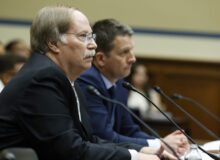By Jonathan Latham, PhD
Pretty much every branch of the US government has had trouble implementing President Obama’s flagship scientific integrity policy. In 2011, the US Department of the Interior (DOI) appointed the scientist Dr. Paul Houser to be its first ever Officer of Scientific Integrity. Within a year he was fired. Believing his dismissal was for drawing attention to a scientifically questionable Department policy, Houser formally accused the DOI of “scientific and scholarly misconduct and reprisal.” But because the Department of the Interior had fired him, they no longer had a scientific integrity officer for him to complain to.

The US Department of Agriculture (USDA) has had a new scientific integrity policy since 2013. Despite that policy, the non-profit Public Employees for Environmental Responsibility (PEER) recently petitioned USDA saying that “suppression and alteration of scientific work for political reasons remain common at USDA” and that agency scientists “routinely suffer retaliation and harassment” when their work offends agribusiness.
About the Environmental Protection Agency (EPA), the worst that had been said was that, four years after the President’s promise, the agency still had not hired anyone; plus that its outline for a Scientific Integrity Plan lacked integrity. But that was before publication of its first ever Scientific Integrity report.
The President’s promise falters at EPA, too
Back in November 2009, in his first inaugural address, President Obama committed again to what had by then become a major and much-discussed campaign promise: to “restore science to its rightful place”.
The Presidential promise followed a series of Bush era government scandals, such as letting Vice-President Dick Cheney’s staff edit global warming reports. The scandals showed repeated attempts by business lobbies, and the Federal Government itself, to obstruct and distort scientific policy-making, scientific data, and scientific advice.
The President’s chosen method to “restore science” was to create officers of scientific integrity at federal agencies and government departments. These officers would investigate all complaints relating to scientific integrity, whether from insiders or outsiders.
In 2013, after delays even more lengthy than at other agencies, EPA finally appointed Dr Francesca Grifo, formerly of the scientific integrity programme of the Union of Concerned Scientists. Grifo thus became the inaugural EPA Official of Scientific Integrity (ScIO) and also the Obama integrity appointee with the highest profile and expectations.
It was an event of unreported but considerable interest therefore, when Grifo and her assistant last month published the EPA’s first ever annual Report on Scientific Integrity.
The Integrity Report was very revealing. It showed, firstly, that EPA’s new ScIO dismissed, without any investigation, 23 of the 40 complaints received in its first full year of operation.
The reason given for the 23 dismissals is that they were anonymous. All but one of these 23 anonymous complaints were from EPA staff.
Of the 17 remaining complaints, 3 were passed to other EPA offices, again without investigation. Ten are in an unspecified “inquiry phase”. EPA’s Scientific Integrity Officer has therefore resolved just three of the 40 cases submitted to it. These are all described as “minor.” One was resolved and dismissed. The fate of the remaining two is unknown since they are not described in the report.
Responsibility for integrity at EPA
At EPA, Grifo and her assistant are supposed to work with a new committee, comprising existing EPA officials from all of its functional departments and regional offices. A result of this arrangement, however, is that Grifo’s independent powers are limited.
The 2014 report describes for the first time the protocol Grifo developed for handling complaints. It makes clear that the rerouting by her office of allegations (i.e. those not already dismissed for being made anonymously) to other EPA offices, without performing any investigation, is a policy:
“If the allegation concerns waste, fraud, or abuse or other criminal violations, the allegation would be referred to the OIG (Office of the Inspector General). If the allegation involves reprisal, it would be referred to the OIG or the Office of Special Counsel. If the allegation concerns a financial conflict of interest or other ethics issue involving federal employees it would go to the appropriate Deputy Ethics Official or Office of General Counsel/Ethics, or Human Subjects Research Review Official, as appropriate.”
This leaves Dr. Grifo with only those “lapses of scientific integrity” that have no broader (i.e. ethical or criminal) implications. These include cases of scientific authorship, censorship and peer review.
But even if an integrity complaint were to be substantiated by the new ScIO, the most that Grifo and her “review team” can do is write a “recommendation report.” This is because Grifo, the report also reveals, has no authority to determine sanctions. Any “administrative and or corrective action is determined by the direct line supervisor or other manager.” This is allegedly to protect the rights of EPA employees.
For Jeff Ruch, Executive Director of the public accountability nonprofit PEER, the new report lacks sufficient information and transparency, which in turn reflects long term problems at EPA:
“From the EPA scientists who come through our door we hear tales of suppression, arbitrary decision-making and reprisal.” Yet, says Ruch, “EPA never admits that it has scientific integrity issues of any kind that need correction or improvement, thus the policies are presented as sort of superfluous window-dressing.”
As Dr Grifo said (when she was head of UCS’s scientific integrity program) about the firing of Paul Houser from the DOI “I have to say, this doesn’t smell right.”
Former EPA whistleblower, William Sanjour, who is an advisor to the National Whistleblower Center told Independent Science News that:
“This Office of Scientific Integrity is just another EPA public relations office designed to give the impression that the people can influence the agency. Without a specific mandate from Congress this office has no such authority and is only there to give the public and EPA staff the false impression that it has the power to change things. Its real function is to keep complaints from going outside the government’s control.”
Allison Wilson, Science Director of The Bioscience Resource Project, sees a yet more worrisome implication:
“The president has made strong statements about the importance of scientific integrity, which we agree with. But if actions speak louder than words then President Obama cares no more about scientific integrity than did his predecessor. Vast sums of money are spent on science, but no one wants to take simple steps to ensure its independence. That’s a scary thought. Science absolutely requires independence and integrity. Without them science ceases to be science. It becomes a tool to manipulate people.”
Correction (10:31am, Mon 20th): An earlier version of this report stated that: “Of the 17 remaining complaints, 14 were passed to other EPA offices, again without investigation. EPA’s Scientific Integrity Officer has therefore investigated just three of the 40 cases submitted to it. These are all described as “minor.” One was resolved and dismissed. The fate of the remaining two is unknown since they are not elaborated on in the report.” The version in the main text is now correct.







